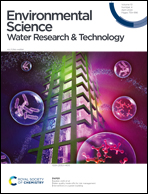Analysis of design criteria for biological post-treatment of ozonated wastewater treatment plant effluent†
Abstract
To protect surface waters and related water cycles from organic micropollutant emissions, numerous wastewater treatment plants (WWTP) in Europe have been upgraded with ozonation followed by biological post-treatment. In contrast to ozonation, biological post-treatment still lacks an objective-driven design approach based on defined parameters. The removal of potentially toxic oxidation products formed during ozonation is the undisputed purpose of biological post-treatment. However, the wide variety of studied oxidation by-products (OBP), ozonation transformation products (OTP) and toxicity endpoints so far hampered the definition of specific design parameters. This study proposes a two-step design approach for biological post-treatment of ozonated WWTP effluent and analyses the results in comparison with common practice. The first step provides guidance for the selection of the post-treatment process based on mandatory treatment goals (removal of biodegradable OBP and toxicity) and site-specific optional treatment goals (e.g. phosphorus removal). The second step consists of a dimensioning procedure that focuses on carbonyl compounds as suitable representatives of biodegradable OBP and assumes first-order kinetics for calculating empty bed contact times (EBCT) as a function of the targeted removal efficiency. The design approach was exemplarily applied to a real WWTP. BAC filtration with additional coagulant dosing was selected as the most suitable process for the site-specific treatment requirements. To reach an overall removal of 80% for a set of 7 selected target carbonyl compounds, an EBCT of 16 min was determined. The dimensioning results were compared with a common practice approach that is based on a maximum hydraulic loading rate. The filter surface area and EBCT calculated with the novel approach were approx. 20% higher than for the common practice approach, when assuming the same filter bed heights. Since the common practice approach only defines the filter surface area, the discrepancy in EBCT can drastically increase if the bed height is reduced. This demonstrates that EBCT-based dimensioning approaches are essential for ensuring an efficient OBP removal in biological post-treatment. The first-order kinetic model for OBP degradation enables to define the EBCT according to OBP treatment goals and to thoroughly compare different design options.



 Please wait while we load your content...
Please wait while we load your content...